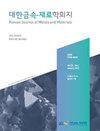利用生物质还原炼铁过程中二氧化碳的替代还原剂的开发
IF 1.4
4区 材料科学
Q4 MATERIALS SCIENCE, MULTIDISCIPLINARY
引用次数: 0
摘要
自20世纪90年代初以来,为了应对全球气候变化,钢铁行业积极开发了减少二氧化碳排放的技术。特别是,包括木材、竹、草、食品和农业副产品在内的各种类型的生物质正在尝试在高炉过程中作为碳中和的燃料进行利用。在本研究中,开发了一种利用生物质替代焦炭和煤粉的还原剂,并评估了其对高炉性能和CO2还原的影响。第一项研究是由与铁矿石和煤混合的烘干生物质制成的炉料(含铁生物质焦炭,IBC)是否可以以碳化型煤的形式用作焦炭的替代品。此外,还研究了一种将烘干生物质与煤粉(Bio-PC)混合在高炉风口喷射的方法。结果,当用10%的IBC代替焦炭时,烧结矿的还原性随着CO气体利用率的提高而提高,因此CO2排放量减少了2.3%。此外,与10%的烘干生物质混合的Bio-PC的燃烧效率提高了13.2%,因此,CO2排放量计算减少了4%。这些结果表明,在高炉中使用IBC和Bio-PC是可能的,因为它们可以有效地减少炼铁过程中的二氧化碳排放。本文章由计算机程序翻译,如有差异,请以英文原文为准。
Development of Alternative Reductant using Biomass for Reducing CO2 in Ironmaking Process
Technologies to reduce CO2 emissions in the steel industry have been actively developed since the early 1990s in order to deal with global climate change. In particular, the utilization of various types of biomass including wood, bamboo, grass, food and agricultural by-product are being attempted as carbon neutral fuels in the blast furnace process. In this study, an alternative reducing agent for coke and pulverized coal using biomass was developed and the effect on blast furnace performance and CO2 reduction was evaluated. The first investigation was whether a burden material made of torrefied biomass mixed with iron ore and coal (Iron-bearing Biomass Coke, IBC) could be used as a substitute for coke in the form of a carbonized briquette. In addition, a method of mixing torrefied biomass with pulverized coal (Bio-PC) to inject through tuyere in a blast furnace was examined. As a result, when coke was replaced with 10% of IBC, the reducibility of the sintered ore was improved in association with an increased CO gas utilization ratio, hence CO2 emissions decreased by 2.3%. Furthermore, the combustion efficiency of Bio-PC mixed with 10% of torrefied biomass was improved by 13.2%, thus, the amount of CO2 emissions was calculated to decrease by 4%. These results suggest that the possibility of using IBC and Bio-PC in blast furnaces, as they could effectively reduce CO2 emissions in the ironmaking process.
求助全文
通过发布文献求助,成功后即可免费获取论文全文。
去求助
来源期刊

Korean Journal of Metals and Materials
MATERIALS SCIENCE, MULTIDISCIPLINARY-METALLURGY & METALLURGICAL ENGINEERING
CiteScore
1.80
自引率
58.30%
发文量
100
审稿时长
4-8 weeks
期刊介绍:
The Korean Journal of Metals and Materials is a representative Korean-language journal of the Korean Institute of Metals and Materials (KIM); it publishes domestic and foreign academic papers related to metals and materials, in abroad range of fields from metals and materials to nano-materials, biomaterials, functional materials, energy materials, and new materials, and its official ISO designation is Korean J. Met. Mater.
 求助内容:
求助内容: 应助结果提醒方式:
应助结果提醒方式:


